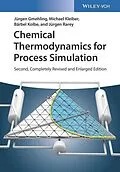Das einzige Lehrbuch, nun in der 2. Auflage, das die Thermodynamik auf praktische Probleme der Verfahrenstechnik anwendet, unzählige Beispiele mit Lösungen, Schätzmethoden zu thermophysikalischen Eigenschaften usw. präsentiert.Auch für Ingenieure bei Chemiefirmen von Interesse.
Autorentext
Jurgen Gmehling, PhD, is Professor of Chemical Engineering at the University of Oldenburg, Germany. He is also president and CEO of DDBST GmbH, Oldenburg, as well as cofounder of LTP GmbH, part of the Carl von Ossietzky University of Oldenburg.
Michael Kleiber, PhD, works as a Chief Development Engineer for ThyssenKrupp Uhde, Germany.
Barbel Kolbe, PhD, is a senior process engineer for ThyssenKrupp Uhde, Germany.
Jurgen Rarey, PhD, is a professor at the University of Oldenburg, Germany, and cofounded DDBST GmbH, Oldenburg. He is also an honorary professor in Durban, South Africa.
Zusammenfassung
The only textbook that applies thermodynamics to real-world process engineering problems
This must-read for advanced students and professionals alike is the first book to demonstrate how chemical thermodynamics work in the real world by applying them to actual engineering examples. It also discusses the advantages and disadvantages of the particular models and procedures, and explains the most important models that are applied in process industry. All the topics are illustrated with examples that are closely related to practical process simulation problems. At the end of each chapter, additional calculation examples are given to enable readers to extend their comprehension.
Chemical Thermodynamics for Process Simulation instructs on the behavior of fluids for pure fluids, describing the main types of equations of state and their abilities. It discusses the various quantities of interest in process simulation, their correlation, and prediction in detail. Chapters look at the important terms for the description of the thermodynamics of mixtures; the most important models and routes for phase equilibrium calculation; models which are applicable to a wide variety of non-electrolyte systems; membrane processes; polymer thermodynamics; enthalpy of reaction; chemical equilibria, and more.
-Explains thermodynamic fundamentals used in process simulation with solved examples
-Includes new chapters about modern measurement techniques, retrograde condensation, and simultaneous description of chemical equilibrium
-Comprises numerous solved examples, which simplify the understanding of the often complex calculation procedures, and discusses advantages and disadvantages of models and procedures
-Includes estimation methods for thermophysical properties and phase equilibria thermodynamics of alternative separation processes
-Supplemented with MathCAD-sheets and DDBST programs for readers to reproduce the examples
Chemical Thermodynamics for Process Simulation is an ideal resource for those working in the fields of process development, process synthesis, or process optimization, and an excellent book for students in the engineering sciences.
Inhalt
Preface xiii
Preface to the Second Edition xvii
List of Symbols xix
About the Authors xxix
1 Introduction 1
2 PvT Behavior of Pure Components 5
2.1 General Description 5
2.2 Caloric Properties 10
2.3 Ideal Gases 14
2.4 Real Fluids 16
2.4.1 Auxiliary Functions 16
2.4.2 Residual Functions 17
2.4.3 Fugacity and Fugacity Coefficient 19
2.4.4 Phase Equilibria 22
2.5 Equations of State 25
2.5.1 Virial Equation 26
2.5.2 High-Precision Equations of State 30
2.5.3 Cubic Equations of State 37
2.5.4 Generalized Equations of State and Corresponding-States Principle 42
2.5.5 Advanced Cubic Equations of State 49
Problems 57
References 60
3 Correlation and Estimation of Pure Component Properties 63
3.1 Introduction 63
3.2 Characteristic Physical Property Constants 63
3.2.1 Critical Data 64
3.2.2 Acentric Factor 69
3.2.3 Normal Boiling Point 69
3.2.4 Melting Point and Enthalpy of Fusion 72
3.2.5 Standard Enthalpy and Standard Gibbs Energy of Formation 74
3.3 Temperature-Dependent Properties 77
3.3.1 Vapor Pressure 78
3.3.2 Liquid Density 90
3.3.3 Enthalpy of Vaporization 94
3.3.4 Ideal Gas Heat Capacity 98
3.3.5 Liquid Heat Capacity 105
3.3.6 Speed of Sound 109
3.4 Correlation and Estimation of Transport Properties 110
3.4.1 Liquid Viscosity 110
3.4.2 Vapor Viscosity 115
3.4.3 Liquid Thermal Conductivity 120
3.4.4 Vapor Thermal Conductivity 125
3.4.5 Surface Tension 128
3.4.6 Diffusion Coefficients 131
Problems 135
References 138
4 Properties of Mixtures 143
4.1 Introduction 143
4.2 Property Changes of Mixing 144
4.3 Partial Molar Properties 145
4.4 GibbsDuhem Equation 148
4.5 Ideal Mixture of Ideal Gases 150
4.6 Ideal Mixture of Real Fluids 152
4.7 Excess Properties 153
4.8 Fugacity in Mixtures 154
4.8.1 Fugacity of an Ideal Mixture 155
4.8.2 Phase Equilibrium 155
4.9 Activity and Activity Coefficient 156
4.10 Application of Equations of State to Mixtures 157
4.10.1 Virial Equation 158
4.10.2 Cubic Equations of State 159
Problems 169
References 170
5 Phase Equilibria in Fluid Systems 173
5.1 Introduction 173
5.2 Thermodynamic Fundamentals 185
5.3 Application of Activity Coefficients 192
5.4 Calculation of VaporLiquid Equilibria Using gE Models 195
5.5 Fitting of gE Model Parameters 212
5.5.1 Check of VLE Data for Thermodynamic Consistency 218
5.5.2 Recommended gE Model Parameters 227
5.6 Calculation of VaporLiquid Equilibria Using Equations of State 229
5.6.1 Fitting of Binary Parameters of Cubic Equations of State 235
5.7 Conditions for the Occurrence of Azeotropic Behavior 243
5.8 Solubility of Gases in Liquids 252
5.8.1 Calculation of Gas Solubilities Using Henry Constants 254
5.8.2 Calculation of Gas Solubilities Using Equations of State 262
5.8.3 Prediction of Gas Solubilities 263
5.9 LiquidLiquid Equilibria 266
5.9.1 Temperature Dependence of Ternary LLE 277
5.9.2 Pressure Dependence of LLE 279
5.10 Predictive Models 280
5.10.1 Regular Solution Theory 281
5.10.2 Group Contribution Methods 282
5.10.3 UNIFAC Method 284
5.10.3.1 Modified UNIFAC (Dortmund) 291
5.10.3.2 Weak...
